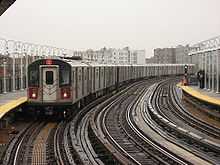R179 (New York City Subway car)
| R179 (New York City Subway car) | |
|---|---|
| Manufacturer | Bombardier Transportation |
| Replaced | |
| Constructed |
2015 (ten pilot cars) 2015–2017 (290 production cars)[1] |
| Number under construction | 300 (260 in 4-car sets, 40 in 5-car sets) |
| Number built | 0 (still in construction) |
| Formation |
65 four-car sets (two B cars) 8 five-car sets (three B cars) |
| Fleet numbers | To be announced |
| Operator | New York City Subway |
| Specifications | |
| Train length |
4-car train: 240.84 feet (73.41 m) 5-car train: 301.05 feet (91.76 m) 8-car train: 481.68 feet (146.82 m) 10-car train: 602.1 feet (183.5 m) |
| Car length | 60.21 feet (18.35 m) |
| Doors | 8 per car |
| Traction system | Bombardier MITRAC AC Propulsion |
| Prime mover(s) | electric motor |
| Electric system(s) | 600 V DC Third rail |
| Current collection method | Contact shoe |
| Safety system(s) | emergency brakes |
| Track gauge | 1,435 mm (4 ft 8 1⁄2 in) standard gauge |
The R179 is a future new technology (NTT) rail car ordered for New York City Subway's B Division. These cars will replace all of the remaining R32 and R42 cars in service, which are running well past the average service life of a New York City Subway car, and to expand the fleet for the Second Avenue Subway. The contract to build these cars has been awarded to Bombardier Transportation,[2][3] who will build the cars in its Plattsburgh, New York facility.
Background
The R179 contract, which originally consisted of 420 cars, was intended to replace all of the R44s. Due to structural integrity issues found on New York City Transit's R44s in early 2010, its retirement was facilitated by option order cars of the R160 car order. The Metropolitan Transportation Authority later dropped the plan to order R179s for the Staten Island Railway, instead opting to overhaul some R46s to replace the existing R44s there. However, the plan to overhaul the R46s for the Staten Island Railway was recently dropped, and new future R211 cars can potentially replace the Staten Island Railway's fleet of R44s instead.
History
The proposed MTA 2010-2014 Capital Program has pointed toward an order of 60-foot (18.29 m) cars.[4] The order is to be broken down into a base order of 300 cars, The MTA Board of Directors approved the award of a contract to Bombardier on March 24, 2012 and signed the awarded contract on June 4, 2012 to Bombardier Transportation for $599 million.
The official RFP was issued on June 3, 2010. Bids were due by the following August 13, but the contract was not awarded until March 24, 2012 to Bombardier Transportation.[2] The contract specified the purchase of 290 cars with 250 arranged as 5-car sets and the remaining 40 arranged in 4-car sets, with the 50 Option I cars arranged in 5-car sets. There was also a second option for 80 additional cars, pending funding.[5] As of January 2012, the base order had been amended to a total of 300 cars, 260 of which will be in 4-car sets, and 40 of which will be in 5-car sets, with no options [6]
The order of the R179 series was not without controversy. A 2012 news report from the New York Daily News[7] indicated that an official at the Metropolitan Transportation Authority (NYCTA's Chief Mechanical Officer of the Car Equipment Division) had been in talks with car builder Bombardier Transportation, Inc. for a job. This prompted an ethics investigation, but has since been resolved.[8]
The base order will retire all remaining R32s (222 cars) and R42s (50 cars). Any additional cars ordered will be used for fleet expansion for the opening of the first phase of the Second Avenue Subway or installation of communications-based train control (CBTC).
A non operational mock up was built in late November 2013. Delivery of the first 10-car test train was scheduled for Third Quarter 2014,[1] with delivery of the production cars scheduled to begin July 2015 and continue through January 2017. However, as NYCTA's and Bombardier's inspectors found cracks due to welding issues in the prototype train's chassis, the entire lot was rejected, and the delivery schedule was pushed back by approximately 6 to 11 months.[9][10]
See also
- R143 (New York City Subway car), a similar car built by Kawasaki Railcar Corp. of Kobe, Japan
- R160 (New York City Subway car), a similar car built by Alstom of France and Kawasaki Railcar Corp. of Kobe, Japan
References
- ↑ 1.0 1.1 "Bombardier in the USA – Media Center". Us.bombardier.com. Retrieved 2014-05-07.
- ↑ 2.0 2.1 R179 Staff Summary
- ↑ "Governor Cuomo Announces $600 Million MTA Investment in Upstate Manufacturing | Governor Andrew M. Cuomo". Governor.ny.gov. 2012-03-28. Retrieved 2014-02-21.
- ↑ Page 40 in Adobe Acrobat Reader, Page 36 in document.
- ↑ Page 19
- ↑ http://web.archive.org/web/20131102154300/http://www.mta.info/mta/news/books/pdf/121029_1400_CPOC.pdf
- ↑ "MTA exec Mario Guerra hit on ethics over seeking job with subway-car maker". NY Daily News. 2012-03-28. Retrieved 2014-02-21.
- ↑ "News - Media Centre". Bombardier. Retrieved 2014-02-21.
- ↑ http://web.mta.info/mta/news/books/pdf/140728_1200_CPOC.pdf
- ↑ Donohue, Pete (29 July 2014). "Riders on C train will have to wait longer for new Subway cars". New York Daily News. Retrieved 30 September 2014.
External links
| |||||||||||||||||||||||||||||||||||||||||||||||||||||||||||


